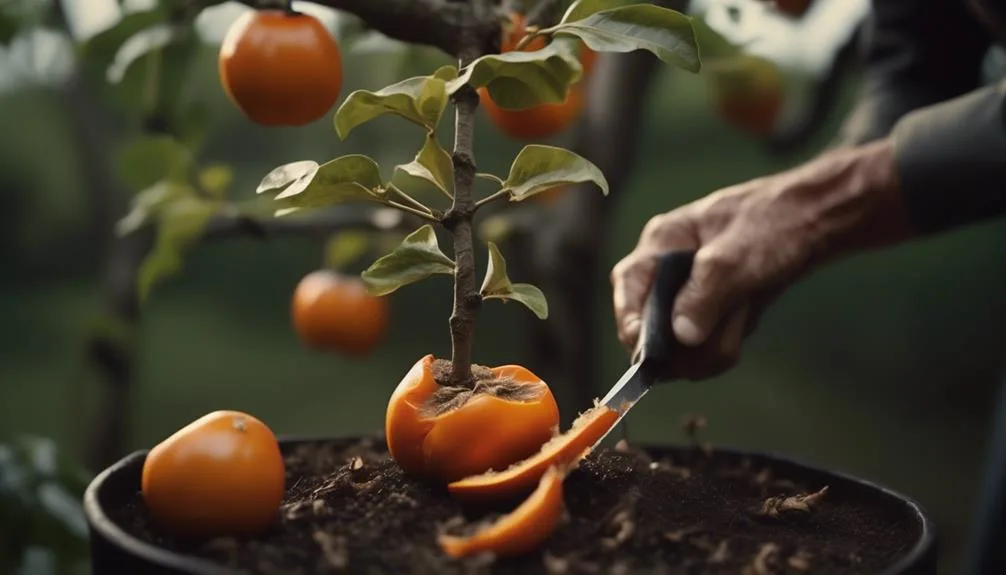Imagine strolling through a calm orchard, surrounded by the sweet smell of ripe persimmons. Now, picture bringing that peacefulness to your own garden by growing persimmon trees from cuttings.
It's a rewarding process that lets you create new trees from your favorite varieties. But where do you start? How do you successfully take a cutting and nurture it into a thriving new tree?
Let's explore the steps and techniques that will help you achieve this gardening goal.
Key Takeaways
- Select a healthy branch with several leaf nodes and make a clean cut just below a leaf node at a 45-degree angle.
- Remove leaves from the lower half of the cutting to reduce moisture loss.
- Keep the cutting moist and plant it in a well-draining potting mix.
- Dip the lower end of the cutting in rooting hormone powder to enhance root development.
Selecting the Cutting
To select the best cutting for propagating persimmon trees, look for a healthy, disease-free branch that's about 8-10 inches long and has several leaf nodes. Choosing the right cutting is crucial for successful propagation.
Make a clean cut at a 45-degree angle just below a leaf node. This will provide a larger surface area for root development. Remove any leaves from the lower half of the cutting to reduce moisture loss. Proper cutting technique is essential to ensure the cutting has the best chance of developing roots.
Keep the cutting moist and plant it in a well-draining potting mix. Place the pot in a warm, bright location, but out of direct sunlight. With the right cutting and proper technique, you can increase your chances of successfully propagating persimmon trees.
Preparing the Cutting
Prepare the cutting by ensuring it's about 8-10 inches long, healthy, and disease-free, with several leaf nodes for optimal root development.
Use sharp, clean pruning shears to take the cutting, making a clean cut just below a leaf node.
It's essential to keep the cutting moist and prevent it from drying out during the process.
Maintain high humidity levels by covering the cutting with a clear plastic bag or placing it in a humidity dome.
Use a well-draining, sterile rooting medium such as a mix of perlite and peat moss to plant the cutting.
Keep the soil consistently moist, but not waterlogged, to support root growth.
Spring and early summer are the best times for taking cuttings, as the warmer temperatures and increased sunlight promote faster root development.
Rooting the Cutting
You can encourage the rooting process by dipping the lower end of the cutting in a rooting hormone powder before planting it in the rooting medium. This will enhance the cutting's ability to develop roots and establish itself as a new tree.
To evoke an emotional response in the audience, consider the following:
- Water Propagation
Watching the cutting grow roots in a glass of water can be incredibly rewarding and provide a sense of accomplishment as new life forms.
- Soil Propagation
Planting the cutting in soil and witnessing the growth of a new tree can evoke feelings of nurturing and connection with nature.
Applying a rooting hormone or choosing natural rooting techniques can help create a successful propagation experience, fostering a sense of satisfaction and fulfillment.
Caring for the New Plant
After successfully rooting the cutting, it's important to provide proper care for the new plant to ensure its healthy growth and development.
When caring for your newly propagated persimmon tree, consider pruning techniques. Regular pruning helps shape the tree, promotes strong branch structure, and encourages fruit production. Remove any dead, damaged, or crossing branches to maintain a healthy and open canopy.
Additionally, pay close attention to soil composition. Persimmon trees prefer well-draining soil with a slightly acidic to neutral pH. Amend heavy clay soils with organic matter to improve drainage and fertility. Keep the soil consistently moist but not waterlogged, especially during the tree's early growth stages.
Transplanting the New Tree
When your newly propagated persimmon tree has established strong roots and healthy growth, it's time to carefully transplant it into its permanent location for continued development and fruit production.
Transplanting can be an exciting and rewarding process, as you witness the growth of a tree you nurtured from a cutting. Here's what you need to do:
- Soil Preparation and Watering
Prepare the new planting site by loosening the soil and incorporating organic matter to ensure good drainage and fertility.
Water the tree thoroughly before and after transplanting to help reduce transplant shock and encourage root establishment.
- Sunlight Exposure and Pest Control
Choose a location with full sun exposure for optimal fruit production.
Monitor the tree regularly for pests and diseases, and apply appropriate control measures as needed.
Transplanting your persimmon tree with care and attention will set the stage for its successful growth and bountiful harvests.
Conclusion
In nurturing a new persimmon tree from a cutting, your diligence and care will soon yield a thriving addition to your garden. Remember to maintain the cutting's moisture and provide the optimal rooting conditions.
With patience and attention, you can look forward to the gratifying sight of a flourishing persimmon tree. Happy propagating!

